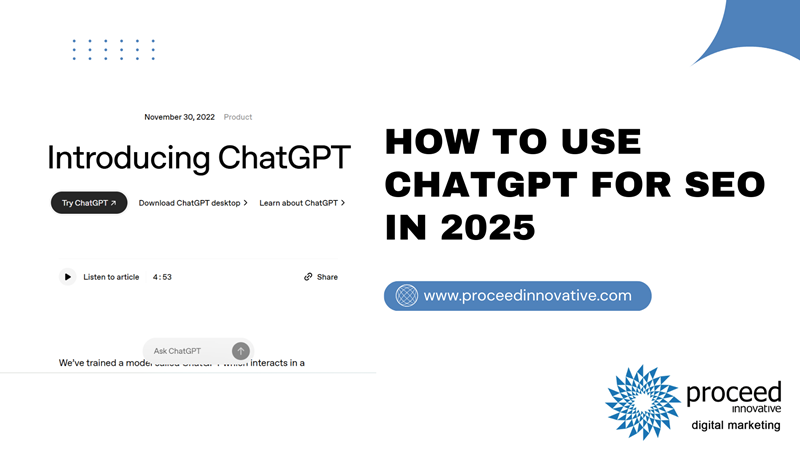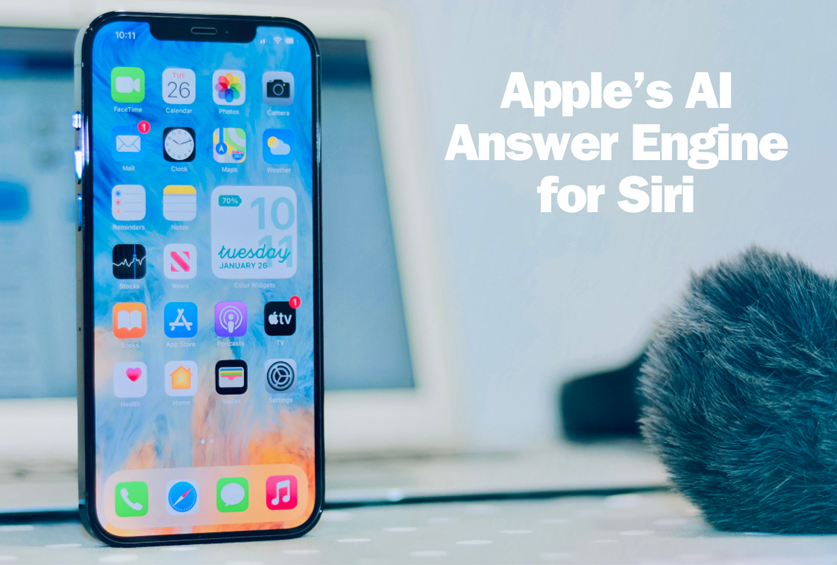ChatGPT made a huge entrance on the scene during late 2022 and shot to fame in record time as one of the most widely spoken about AI assist tools on the digital stage. OpenAI anticipates making approximately $12.7 billion in revenue in 2025, a sizable increase from the $3.7 billion reported in 2024. This growth is primarily driven by the success of its ChatGPT product and expanding enterprise offerings. The company is also projecting revenues to reach $29.4 billion by 2026 .
Since marketers are tapping the enormous potential of AI for digital marketing, one area that is experiencing unprecedented innovation is search engine optimization (SEO). From keyword research to content creation and technical audit, ChatGPT is unveiling tremendous new possibilities for enhancing search visibility and performance.
ChatGPT is still so young, yet already there is so much that it can do to help you with SEO.
In this blog post, I’ve compiled 10 of the most helpful ChatGPT uses to create improved SEO strategies.
What is ChatGPT, And Why Do People Want It So Badly?
ChatGPT-3, or “Generative Pretrained Transformer 3,” is a chatbot AI that can mimic actual conversations with a human individual, web search data, joke, generate ideas, etc.
The benefits of ChatGPT soon echoed loud and clear to the masses after being launched in November 2022. ChatGPT is getting a lot of press. Some of it is due to its great AI technology. However, most of it is because it is a fantastic product. Open AI captures the user experience of chatbot and adds the breadth of possibilities in artificial intelligence.
How To Use ChatGPT for SEO ( Search Engine Optimization )
There are various aspects to SEO, ranging from on-page to technical adjustments to creäte useful user-friendly content for readers, etc.
Depending on what information you input into ChatGPT, you can achieve some pretty cool things to integrate into your Local SEO strategy.
We all have tried out ChatGPT with all manner of SEO tasks to explore what kind of results it could generate for us.
Keep in mind that some answers won’t be appropriate for your SEO purposes, and facts aren’t always accurate. ChatGPT currently only stores internet data through 2021, and even that gets things wrong occasionally. So be careful what you take from ChatGPT and always verify to ensure it is correct.
Here Let’s see how powerful a ChatGPT marketing strategy is for your site’s SEO.
1. Find Keywords to Your Target Audience
As a start, you can ask ChatGPT to give you a list of related keywords to the ones you’re focusing on for your own business or client.
Assuming you’re the owner of a Plumbing business in Chicago, and need to make your business more visible.
Ask ChatGPT for related keywords to ” Emergency local plumber in Chicago.”
You may get more variation, search the internet people use to find out your product or services, that actually work and you even did not think about it.
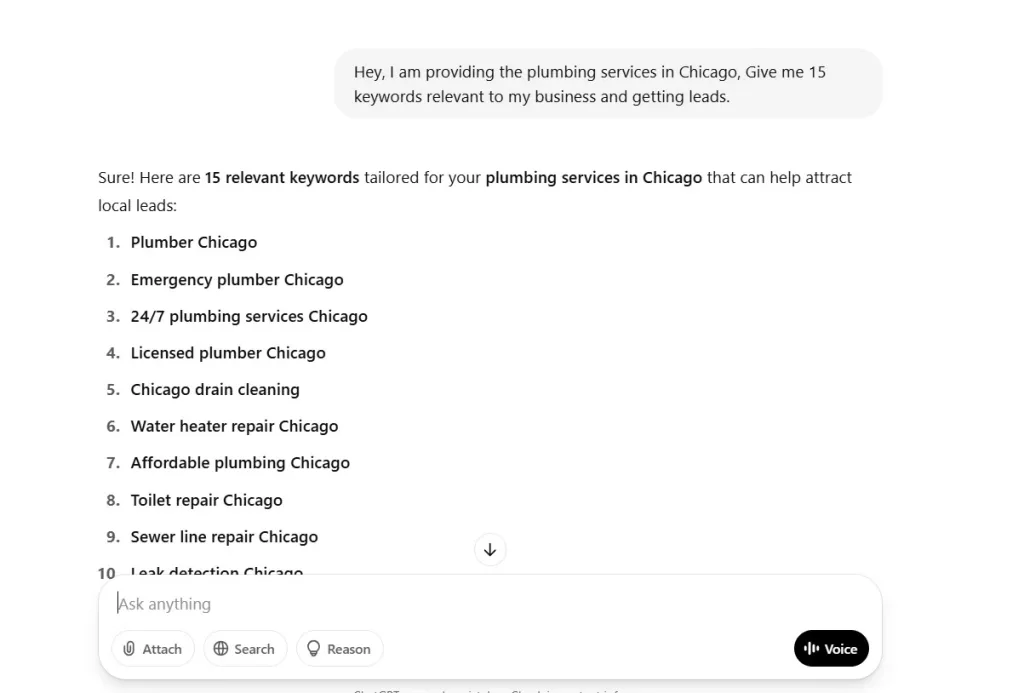
You might never have considered going after terms like “tankless water heater installation Chicago,” “emergency plumber near me,” or “eco-friendly drain cleaning services,” but depending on your business location and customer base, there could be quite specific search traffic within those niches.
It’s easy to focus on broad terms like “Chicago plumber,” but your competition likely is as well. If you look deeper into more niche services, customer pain areas, and unserved search intent, you can see your plumbing company in front of people looking to hire, and most importantly, overlooked.
ChatGPT won’t write your entire SEO plan, but it can help discover fresh angles of content. Think about service-type blog posts like “What to Do If Your Basement Flooding Occurs in Lincoln Park,” or local pages for high-intent searches like “Wicker Park Emergency Pipe Burst Repair.”
It is all about identifying the precise places where what you are offering intersects where people need it — and that is where good keyword research and creative thinking come together.
2. Build Content Around Certain Topics
Once you’ve selected your keywords — like “emergency plumber in Logan Square” or “sump pump installation in Chicago” — it’s time to build content that can actually rank for them.
With the help of ChatGPT, you can plug in those keywords, give it a clear topic, and let it generate relevant, location-targeted content. For example:
- Use “water heater repair Chicago” to create a blog post titled “5 Signs Your Water Heater Needs Repair (And Who to Call in Chicago)”
- Take “clogged drain plumber Near North Side” and turn it into a landing page optimized for local search
- Or build an FAQ section around terms like “how to prevent frozen pipes in Chicago winters”
This type of focused content gets your plumbing business on local search when people are actually looking for solutions, and positions you as the one to be who has them.
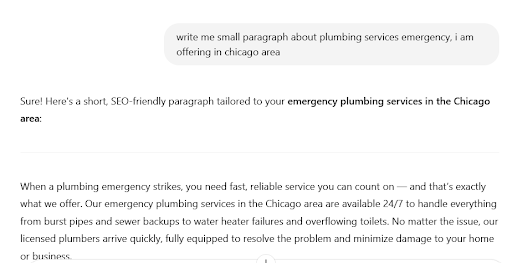
Notice the purpose of the question — by having me respond as a small business owner, ChatGPT modifies the reply in turn to that voice and perspective.
But digital marketers must be cautious when utilizing AI-created content. While tools such as ChatGPT are great at generating ideas and first drafts, there is always a risk of mistakes or repeated wordings that can end up plagiarizing what already exists on the internet.
Instead, think of ChatGPT as a brainstorming aid — it can help you get your content started, but always make sure to read, edit, and put your own voice into it so that it’s yours. If time or budget is an issue, such as with Undetectable AI, you can successfully humanize AI content without losing brand tone.
3. Create a Keyword List That Aligns with Search Intent
ChatGPT is not just useful for generating content—it’s also a great keyword discovery tool. Just by applying audience filters (e.g., small business owners), you can have ChatGPT generate super-relevant, intent-based keyword suggestions.
By listening to search intent—what your users are searching for—you can more effectively craft an SEO strategy. Are they out to repair something, learn about a solution, or buy something? ChatGPT can help you determine terms they would use normally.
Ask yourself: What are your ideal customers looking for that would lead them to your product or service?
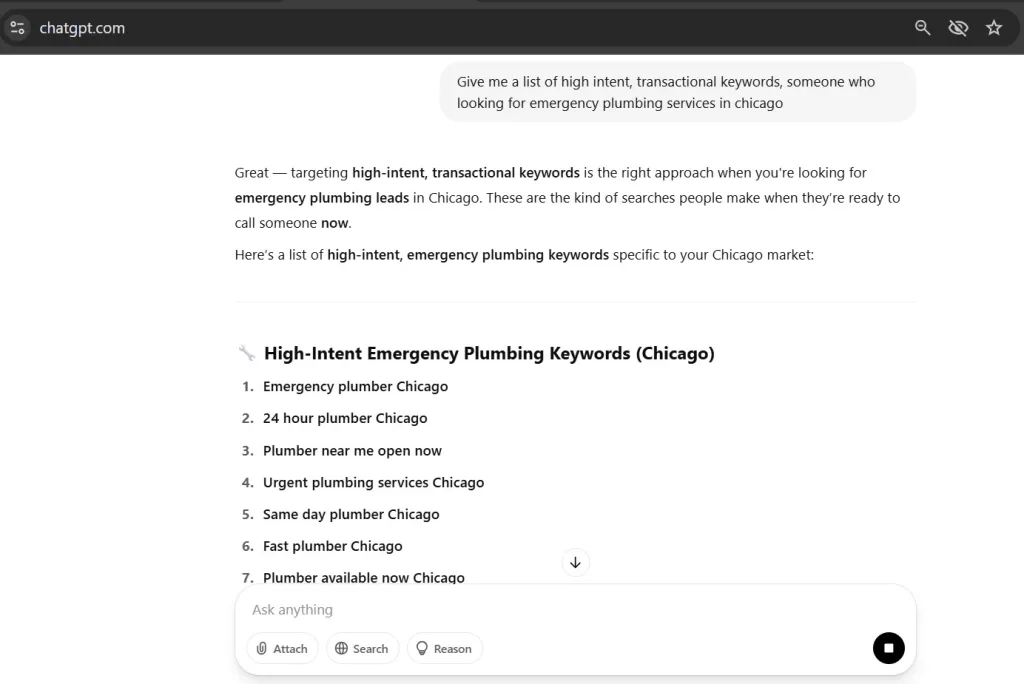
Always express it in terms of meeting what the customer is seeking, not listing what your business does. Customers seek solutions to problems, rapid answers, and confirmation that you understand their needs.
And while ChatGPT can be a great resource for coming up with content ideas or sample text, that does not mean every suggestion is golden. Use AI as a starting point, but do your keyword research and validate the intent of your searchers. That way, you can ensure the content you create is not only optimized but is useful to the people searching for your services.
4. Write Meta Titles and Descriptions
ChatGPT can even help you generate some alternative versions of meta titles and meta descriptions for your web pages. Having some alternative versions, you can pick and mix the best of each to come up with an attractive and optimized snippet that can make you gain more visibility and clicks in search results.
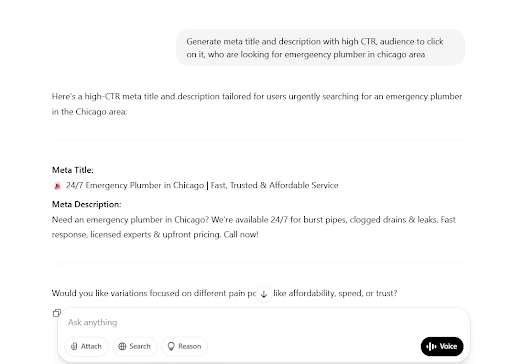
Remember, your meta titles and descriptions should do more than just rank well—they should also sound like you. Keep the human touch in your copy to reflect your brand’s voice and tone. And if there are specific keywords you’re targeting, make sure to include those naturally in your final version.
5. Create FAQs
If you wish to discover the most popular questions that are being asked about a product or service that you have to provide, you can query ChatGPT instead of searching yourself.
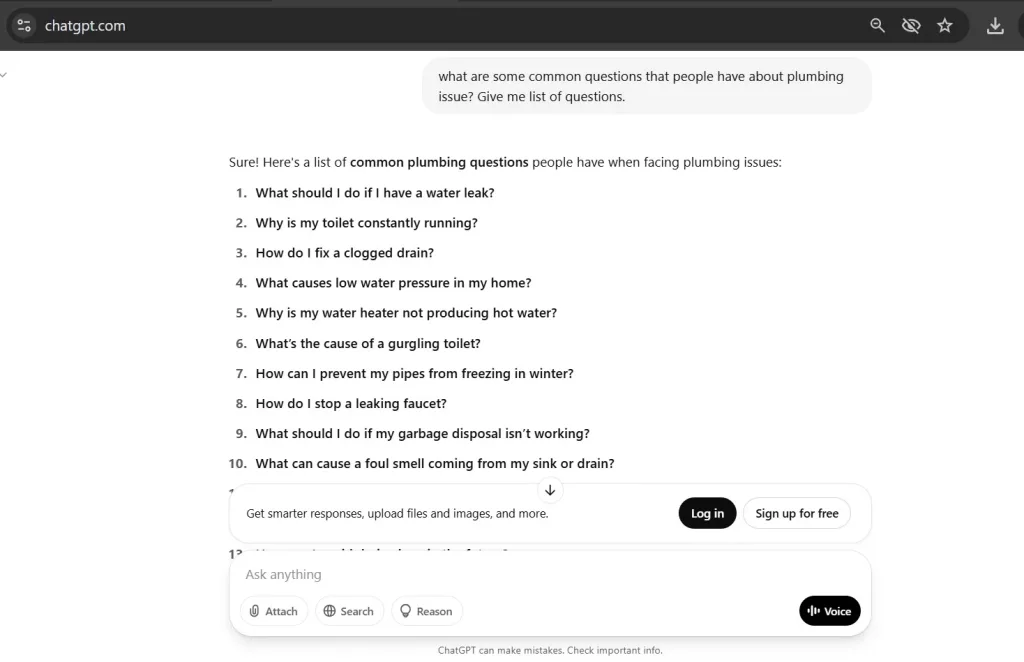
You can make an effective list of typical questions using basic SERP FAQ research and AnswerThePublic-type tools.
6. Provide You with A List of Potential Topics for Your Content Strategy
Marketers are discovering how much a ChatGPT content creation strategy can do for them since the time used on topic creation is so valuable.
Assume you own a small landscaping business. ChatGPT can help in coming up with content ideas such as “Winter Lawn Care Tips” or “5 Best Plants for Low-Maintenance Gardens.” By creating informative and helpful content, not only do you educate your audience, but you also draw the spotlight towards your expertise and the professional services your company offers.
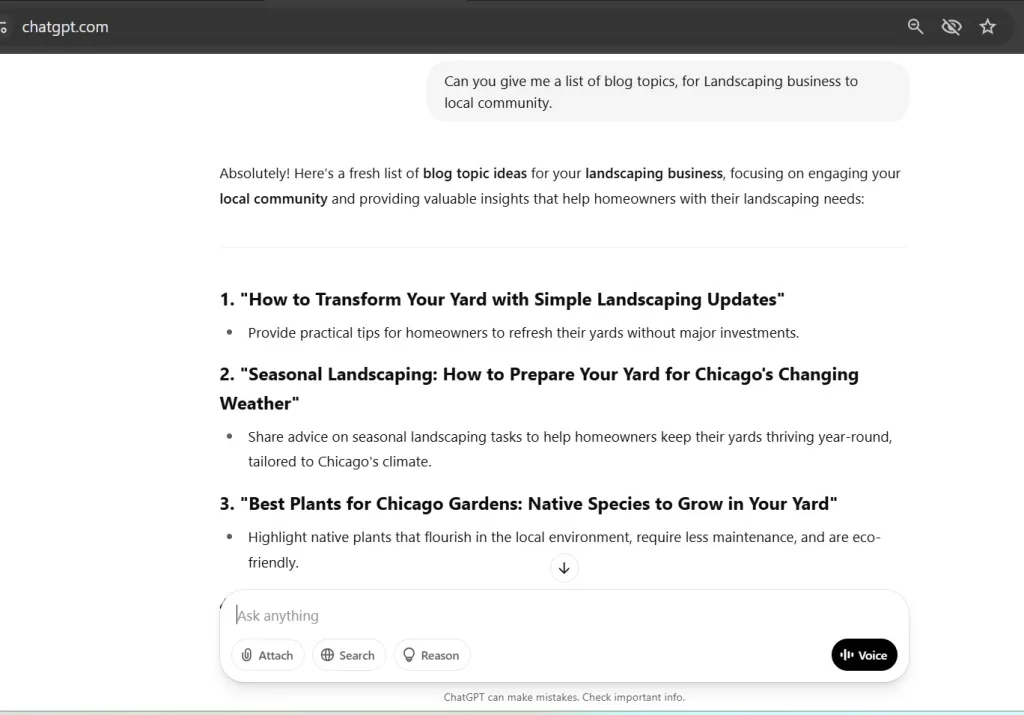
7. Check with Google for helpful content optimization
To make your content according to Google Helpful Content standards, start with creating content that meets the specific needs of your users. Once you have your first copy ready, you can also use tools like ChatGPT for proofing and smoothing your content. By such means, it is simple to find clumsy phrasing mistakes, correct them, and present your content in an improved level of readability as well as becoming even more user-friendly. By doing so, you create content that is both relevant to readers and search-performance-optimized.
8. Create Emails for Backlink Opportunities
Try to use ChatGPT to write your backlink outreach email. I put it to the test by providing it with a fairly weak prompt—asking it to write the email “as if I was desperate for traffic.” Of course, no website will be linking to a website that appears desperate, so ChatGPT did not take the prompt literally. Instead, it piped up, reprimanded the assignment mistake, and provided a better option to build a stronger outreach email.
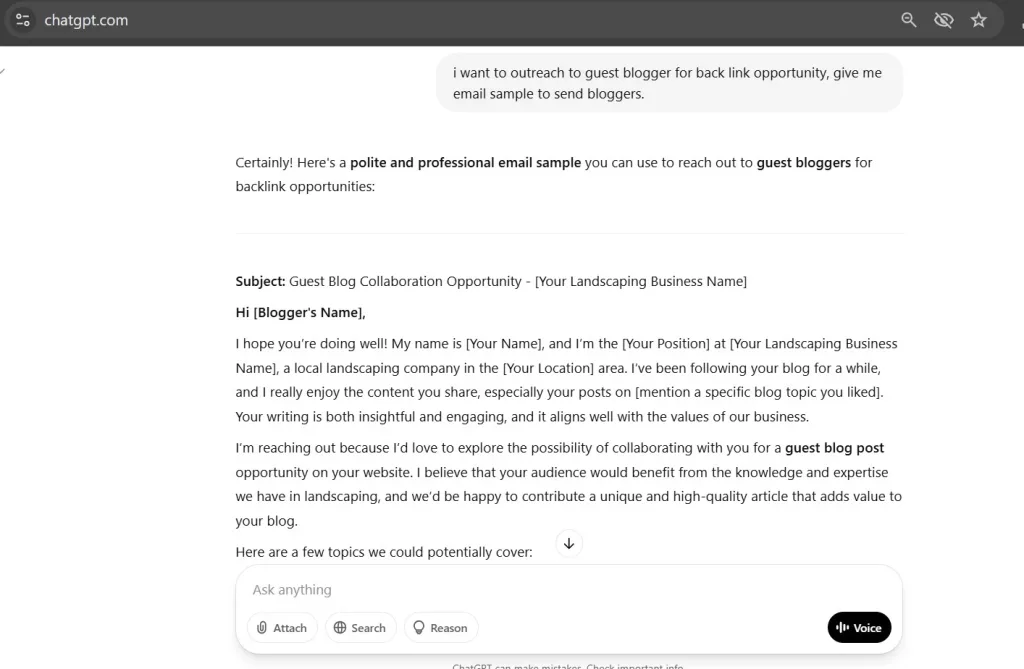
9. Generate Schema Markup
Schema markup is a form of code that allows search engines to understand and provide what’s on your website. Schema markup is essentially a “language” that contains specific data provided to search engines, allowing them to present your content in a more structured form.
There are a lot of schema types you can add, including:
- FAQs
- Video facts
- Prices
- Ratings and reviews
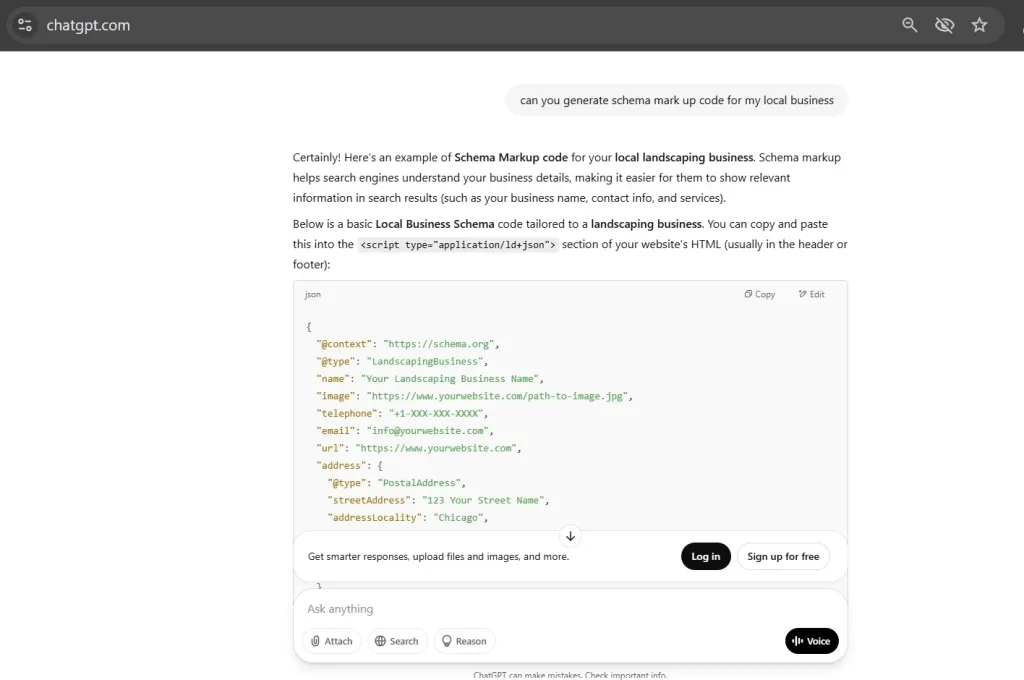
Although schema markup is fantastic for SEO, most people don’t understand how it does it. Well, that’s where AI comes in—why not let it generate the schema markup for you?
10. Create Regular Expression (Regex) Patterns
Regular expressions (regex) are a tool for text searching, matching, and manipulating. They allow you to find specific patterns, such as payment methods like “credit card,” “debit card,” or “wire transfer,” in large data sets. Whether you’re processing logs, scraping the web, or making data reporting better, regex makes it quicker and easier with accuracy and versatility.
If you wish to find out more about regex functions, I suggest visiting Google’s regular expression guide for further information. But let’s get back to ChatGPT and find out further how it can assist you with your questions or tasks!
FAQs:
Is the ChatGPT app free?
ChatGPT offers both a free and paid account. The free one gives you access to OpenAI’s chatbot if and when it is available, but it doesn’t guarantee this and will likely be subject to longer wait times during peak times. The paid one, however, offers priority access during peak times and unlocks extra new features that are unique.
What does GPT stand for in ChatGPT?
GPT in ChatGPT stands for “Generative Pre-trained Transformer.”
“Generative” suggests that the model can generate text, “pre-trained” highlights the fact that it has received extensive training on a vast corpus, and “Transformer” refers to the specific architectural style that powers the model’s ability to process and understand language.
Conclusion
In conclusion, ChatGPT has proven to be a powerful tool for SEO and content marketing. It offers valuable support in research, ideation, and writing—but it’s important to remember that over-reliance on AI can come with limitations.
The best results come from combining human creativity with AI assistance. When used strategically as a supplement to your marketing efforts, ChatGPT can significantly enhance productivity and output. As the technology evolves, it will be exciting to see how it continues to shape the future of digital marketing.

